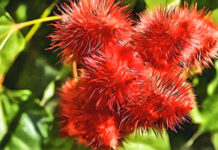The first food ingredient from cellular agriculture submitted for approval as a novel food has received a favorable scientific opinion from EFSA (European Food Safety Authority). Innovative technology is in this case applied to the plant world in order to produce a dietary supplement with an anti-aging function. (1)
1) Plant stem cells
Plants are capable of producing, in meristematic tissues (i.e., at the apex of stems and roots), stem cells that are endowed with the innate ability to undifferentiate. Their cell regeneration by mitosis consists of division into two cells, one of which remains meristematic, grows and prepares for a new division, while the other is destined to differentiate to become part of plant-specific tissues. They are therefore called ‘totipotent cells’. (2)

Plant stem cells are subjected to culture, or cell agriculture, to be propagated to obtain either plants or plant tissues or specific cells from which to obtain and extract individual metabolites. Such as phenolic compounds (3) – bioactive substances with antioxidant, anti-inflammatory and protective actions – with enormous potential in the production of functional ingredients (for food, pharmaceutical and cosmetic use).
2) Use of plant stem cells in dietary supplements
Mibelle Group Biochemistry (CH) had submitted on April 14, 2020, an application for authorization to place on the EU market a food supplement intended for the adult population, obtained from biomass produced by cell culture of apples of the Uttwiler Spätlauber variety.
The ingredient that is the subject of the novel food application, PhytoCellTec™ Md Nu, is already used by Mibelle Group Biochemistry-a company specializing in the production of ingredients for the cosmetic and nutraceutical industry-in the production of cosmetics with anti-aging and skin-nourishing functions. (4)
The choice of variety is related to the high storage capacity, which allows the skin of the fruit not to shrivel, and not to lose its leaves even in the harsh winter periods. The name Uttwiler is the name of the village where the variety was discovered, while Spätlauber means ‘late foliage.’
3) Plant cell culture, the process
Cellular agriculture in the plant kingdom begins with the explantation of a portion of tissue from the chosen plant, whose wound generates a mass of colorless cells (‘callus’) that activate cellular undifferentiation to regenerate damaged tissue. The callus cells are then cultured-individually or in groups (clusters) as needed-in special culture media. This is followed by a description of the production process of the first novel food candidate from cellular agriculture in the European Union.
3.1) Callus formation
The Swiss apple fruit-in the case of the novel food under consideration-is cut into sections, some of which are placed on a solid culture medium consisting of sucrose, vitamins, minerals and other elements, with agar to solidify the medium. Two plant hormones called 6-benzyladenine (BAP) and 2,4-dichlorophenoxyacetic acid (2,4 – D) are also present.
The primary callus-which consists of undifferentiated cells-is thus stimulated to continuous growth. Some of its selected cells are then used to obtain stock cultures and reserve cultures stored in frozen form to replace the stocks with an approximate frequency of 5 years. All operations must be conducted under absolutely sterile conditions.
3.2) Cell cultivation
Stock culture cells are transferred to 500-mL flasks where the same culture medium is present in liquid form (i.e., without agar). They propagate at room temperature, with gentle handling, keeping essential parameters (e.g., pH, biomass volume, sugar content) under control.
Once the desired values are reached, about 10 percent by volume of the flask is transferred, again under sterile conditions, inside disposable containers (biocontainers) with increasing volumes (e.g., 1 liter, 20 liters, 50 liters).
The entire cultivation process takes 3-4 weeks on average and is considered completed when the sugars in the cultivation medium have been completely metabolized by the cultured cells.
3.3) Production of the ingredient
The contents of the biocontainer of 50 liters is filtered and rinsed with a 0.9 percent sodium chloride (NaCl) solution (i.e., saline), and then mixed in a 15 percent ethanol solution and homogenized under high pressure (1,000 bar) so that the cells can be ruptured. This is followed by heat treatment at 113 °C with an air flow of 300 kg/h.
The cell culture-dried and pulverized using a fluidized bed dryer-is then mixed with isomalt to produce a product that can be stored at room temperature.
4) Characteristics and specifications of the new food
The composition of the biomass obtained from the cell culture was very different-in terms of protein, sodium and fiber-than the reference values given in the OECD (Organization for Economic Co-operation and Development) ‘consensus document’ on apple varieties. (5)
The applicant speculates that these differences can be attributed to the cells developed in the callus (protein), rinsing with sodium chloride solutions (sodium), and the shear stresses to which the cells were subjected during cultivation (fiber).
The novel food consists of a mixture of apple cell culture biomass powder (1.1 to 1.5 percent) and isomalt (98.5 to 98.9 percent) obtained from sugar beet (Beta vulgaris var. saccharifera), which is used as a carrier to facilitate the transport and absorption of the powder into the affected sites.

5) Synthetic hormones
The hormones used to stimulate cell undifferentiation and proliferation (i.e. 6-benzyladenine and 2,4 – D) are synthetic analogs of the plant hormones ‘auxin’ and ‘cytokinin. They are also used extensively for this function in other plants (e.g., bluegrass, yarrow, geranium). As well as to stimulate the production of metabolites such as organic acids, anti-oxidants, and polyphenols (6,7,8).
These substances-as well as pesticides-are subject to ‘Maximum Residues Levels’ (MRLs), according to Regulation (EC) No. 396/2005 and its subsequent amendments. (9) Their use in agriculture are authorized for as phytoregulators and herbicides (primary use), respectively, under Regulation (EC) No. 1107/2009 on plant protection products. (10)
In the present case, the presence of 6-benzyladenine was not identified, while 2,4-D was detected at concentrations slightly above the MRLs (between 0.052-0.056 mg/kg) established for fresh apples, which EFSA nonetheless considers to be of no concern in relation to the intended use.
6) Toxicological information
The in vitro studies submitted by the applicant to evaluate the genotoxicity of the novel food–partly replicated, due to interference from the presence of isomalt–showed no cause for concern of genotoxicity given by the novel food, at the concentrations tested.
In contrast, an in vivo oral toxicity study in mice for 90 days was unusable due to the lack of compositional analysis of the novel food and the failure to describe some endpoints. However, EFSA did not consider this type of study (sub-chronicity) essential to perform the risk assessment.
7) Potential allergenicity
The high concentration of protein in the novel food has received special attention, as apple allergy is one of the most common allergies associated with fruit consumption. At EFSA’s request, the applicant had to provide a comparison of protein expression in the biomass produced with the protein contained in the fruit.
A genetic ontology analysis tried to better characterize the 803 proteins that are present in the biomass and not also in the fruit, but information on the proteomics of apple (Malus domestica) is limited, and the nature and function of these proteins could not be fully investigated. Therefore, it was concluded that these proteins have potential allergenicity, which, however, has not been confirmed.
8) Previous evaluation in Australia and New Zealand
The novel food candidate has already been evaluated, in 2020, by the Advisory Committee on Novel Foods (ANCF) of Food Standards Australia New Zealand. (11) As a result of this evaluation, the ingredient was classified in an intermediate category, as ‘non-traditional food’ but at the same time ‘not novel food’. (12)
FSANZ considered no safety concerns at the proposed conditions of use, up to 10 mg/day in a product consisting of 1-10% apple cell culture and 90-99% isomalt. The same conditions were already considered acceptable, in 2017, for the powder obtained from the fruit cells alone.
9) Interim Conclusions
The scientific opinion under review, referring to a plant-derived ingredient, paves the way for the approval in the European Union of the first food derived from cell culture. It is reasonable to expect that this path will be followed by other operators working on the production of animal-based ‘cell cultures,’ following in the footsteps of the licensing procedures already pursued in Singapore and the US. (13)
The publication of EFSA’s scientific opinion took nearly 40 months, well beyond the ordinary 9-month period stipulated by Novel Foods Regulation (EU) 2015/2283. This delay can be partly explained by the attention given to security assessment. And it is at the same time not very encouraging for those investing in research and development in the Old Continent. (14)
Dario Dongo and Andrea Adelmo Della Penna
Notes
(1) EFSA NDA Panel (2023) Safety of apple fruit cell culture biomass as a novel food pursuant to Regulation (EU) 2015/2283. EFSA Journal 21(7):8065, https://doi.org/10.2903/j.efsa.2023.8065
(2) Aggarwal et al. (2020) Plant stem cells and their applications: special emphasis on their marketed products. 3 Biotech 10:291, https://doi.org/10.1007/s13205-020-02247-9
(3) Dario Dongo, Salvatore Parisi. Polyphenols and health. Immune system friendly vegetables. GIFT (Great Italian Food Trade). 1.4.20
(4) PhytoCellTec™ Md Nu gains positive EFSA opinion as novel food. https://mibellebiochemistry.com/phytocelltectm-md-nu-gains-positive-efsa-opinion-novel-food
(5) OECD (2019) Safety Assessment of Foods and Feeds Derived from Transgenic Crops, Volume 3 – Common bean, Rice, Cowpea and Apple Compositional Considerations. OECD Publishing, https://doi.org/10.1787/f04f3c98-en
(6) Chaabani et al. (2015) Effects of 2,4-dichlorophenoxyacetic acid combined to 6-Benzylaminopurine on callus induction, total phenolicand ascorbic acid production, and antioxidant activities in leaf tissue cultures of Crataegus azarolus L. var. aronia. Acta Physiol. Plant 37:16, https://doi.org/10.1007/s11738-014-1769-4
(7) Karhizi & Kakakei (2010) Effect of 6-Benzylaminopurine, 2,4-Dichlorophenoxyacetic Acid and Indole-3-Butyric Acid on Micropropagation Stages of Achillea biebersteinii. Asian Journal of Chemistry 22(3):2383-2386, https://asianjournalofchemistry.co.in/User/ViewFreeArticle.aspx?ArticleID=22_3_98
(8) Haensch (2007) Influence of 2,4-D and BAP on callus growth and the subsequent regeneration of somatic embryos in long-term cultures of Pelargonium x domesticum cv. Madame Layal. Electron. J. Biotechnol. 10(1):69-77, http://doi.org/10.4067/S0717-34582007000100007
(9) Regulation (EU) 2021/1841 established an overall MRL of 0.01 mg/kg for 6-benzyladenine, while Regulation (EU) 2022-1363 established an MRL of 0.05 mg/kg, specific to apples
(10) Permitted uses and references to the periods of authorization and expiration of authorization are given in Part A (Active substances considered approved under Regulation (EC) No. 1107/2009, i.e., active substances listed in Annex I of Directive 91/414/EEC), item 317 and in Part B (Active substances approved under Regulation (EC) No. 1107/2009), item 94 of the Annex to Regulation (EU) No. 540/2011
(11) FSANZ. Record of views formed in response to inquiries. Updated July 2023. https://www.foodstandards.gov.au/industry/novel/novelrecs/Documents/Record-of-Views-updated-July-2023.pdf
(12) The definitions of ‘non-traditional food’ and ‘novel food’ are contained in Section 1.1.2-8 of Standard 1.1.2 of the Food Standard Code:
– ‘Non-traditional food’ can have the following meanings:
(a) a food that does not have a history of human consumption in Australia or New Zealand; or
(b) a substance derived from a food when that substance has no history of human consumption in Australia or New Zealand other than as a component of that food; or
(c) any other substance, if it or the source from which it is derived has no history of food consumption in Australia or New Zealand,
– ‘Novel food’ is a ‘non-traditional food’ that requires an assessment of public health and safety considerations, taking into account:
(a) Potential adverse effects on humans,
(b) composition and structure of the food,
(c) process by which the food was prepared,
(d) source of origin,
(e) patterns and levels of food consumption,
(f) any other relevant matters.
(13) Dario Dongo. Chicken meat from cellular agriculture, green light in US and kosher certification. GIFT (Great Italian Food Trade). 19.9.23
(14) It should be recalled that EFSA (European Food Safety Authority)-in the eleven years since its establishment under the ‘General Food Law’ (EU Reg. No 178/02)-has been vested with a wide range of competencies in every regulatory area pertaining to the agri-food chain. And its annual budget is still entrusted by the decisions of the European Parliament alone, with no contributions from member states or from operators who apply to the Authority. Therefore, the allocation of adequate resources is essential to ensure food safety in the European Union but also the competitiveness of the sector.









